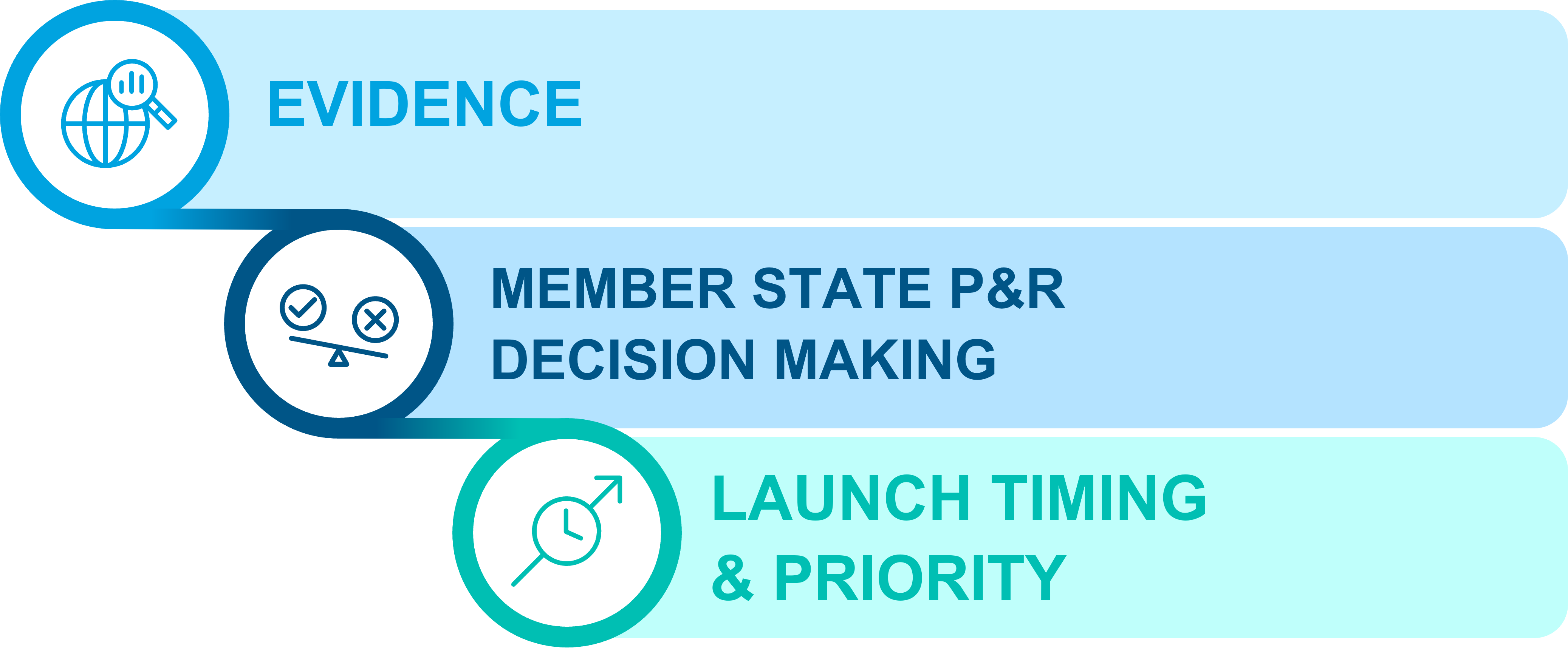Access clearer, more compelling support to demonstrate the value of your product.
EU-wide Health Technology Assessment (HTA) is finally arriving in January 2025 for oncology drugs and ATMPs (Advanced therapy medicinal products), expanding to all patented drugs, in-vitro diagnostics (IVDs) and high-risk medical devices by 2030. Through Joint Clinical Assessment (JCA), the European Commission (EC) aims to harmonize processes and evidence requirements, establish predictability, avoid duplication, and accelerate patient access across EU Member States (MS).
What do we already know?
While few disagree with the intentions of EU HTA, a recent IQVIA Whitepaper explored some of the challenges facing manufacturers and key actions to consider during preparations, including evolution of global cross-functional operating models to account for new dossier timelines, rising evidence generation requirements and earlier affiliate engagement to plan for each Member State’s (MS) evidence/PICO requirements. (Source: IQVIA Whitepaper “The Future of EU HTA” October 2022")
Is it “business as usual” for market access strategy development or is change needed?
To answer this question, we need to examine the potential interplay and impact of JCA on MS evidence requirements and pricing and reimbursement (P&R) processes and decision making. Currently we know that each MS will retain sole responsibility for conclusions on overall clinical added value and P&R. However, to date, few MS and HTA bodies have communicated plans around implementation of the JCA process in their national procedures. Therefore, at this early stage, the interplay is difficult to predict as such this blog investigates three key areas of uncertainty that could impact market access strategies.

EVIDENCE
It is uncertain whether and how the requirements of the JCA process will impact payer evidence requirements at MS level.
How will MS evidence requirements evolve?
Informed decision-making in the selection of comparators and outcomes in clinical development is not a new requirement for successful market access. However, IQVIA expects the JCA to increase payer evidence standards across Europe as methodology development is being driven by the more experienced HTA bodies who are used to “heavier” submissions (e.g., German, French, Dutch) vs. countries with lighter processes (e.g., Czechia, Estonia, Luxembourg). For example, the proposed acceptable effect size is mirroring IQWiG’s effect size thresholds, which sets a high bar for indirect treatment comparisons (ITCs).
Are there products that will be more impacted?
Creating an evidence package that meets the needs of all MS will be challenging, especially for some products. For example, those targeting indications with significant variation in treatment approaches across countries, such as multiple sclerosis or hypertension, could face a vastly different PICO for each MS. A recent IQVIA analysis showed that even in a common oncology indication, at least 10 PICOs would be predicted resulting in a minimum of 280 requested analyses. (Source: IQVIA Poster “Impact of Additive PICOs in a European Joint HTA: A Hypothetical Case Study in Lung Cancer” November 2022). Understanding the populations and comparators relevant to payers in each market and anticipating PICOs based on the EU HTA landscape will be crucial for evidence generation plans. This will require market access teams to engage affiliates earlier (including those from markets historically considered for later launches) to support in anticipating PICO components and bringing forward local clinicians’ and patients’ perspectives.
HTA for combination regimens is already complex under today’s landscape and is expected to remain so with JCA, given that there is no guidance available on how it will apply to combinations. For mixed ownership combinations, it is assumed the JCA burden will fall to the manufacturer updating their regulatory label, e.g., the “add-on” product, as for current HTA submissions.
The complexity of providing an EU-wide dossier submission 45 days prior to CHMP opinion will have varying levels of impact on companies and asset brand teams, depending on their pipeline profiles, size and structure and ways of working/processes. Market access teams should raise early awareness of complex cases for JCA and ensure sufficient resources and time are allocated to succeed.
MEMBER STATE P&R DECISION-MAKING
It is uncertain as to whether and how the European JCA process will align with or influence national level payer P&R decision-making and timelines.
Will the JCA process be a ‘gatekeeper’ for access?
Market access still lies firmly within the sole remit of MS. As the HTA Regulation only requires MS to give “due consideration” to EU JCA reports, it remains unclear how influential JCA will be on individual MS decision-making. Some MS may rely more heavily on JCA reports, resulting in more restrictive market access focused on sub-populations. Others may take the opportunity to leverage the non-confidential JCA report to form new international HTA/procurement collaborations, like BeNeLuxA. More unpredictable still, MS may not take a consistent approach, instead deciding case-by-case how stringently to apply JCA findings. What seems unlikely at this time is that negative commentary in a JCA report will ‘de-facto’ block market access at MS level, given the local P&R process consideration for added value to each MS’s unique treatment landscape and healthcare system.
Will traditional payer archetypes still be valid in Europe?
The influence of a European HTA evidence standard and access to the JCA report may impact the weighting of payer decision-drivers in the MS, creating a shift away from traditional archetypes. It could lead to a “standardisation” of archetypes – e.g., markets adjusting towards Germany’s comparative clinical effectiveness model. This would limit the predictive utility of historical analogues for HTA outcomes requiring manufacturers to re-think the optimal pricing and market access strategy per market and conduct a more in-depth analysis of strategy development.
LAUNCH TIMING AND PRIORITY
Public availability of robustly evaluated efficacy and safety data 30 days after EMA marketing authorization may put pressure on payers to trigger P&R processes and expedite access decisions, especially for products demonstrating patient-relevant benefit.
Will traditional launch sequence strategies need to evolve?
Traditionally, EU launches are staggered in waves of priority order. Access to the JCA outcome may allow resource-constrained MS to accelerate P&R evaluations, putting pressure on manufacturers not to relegate these markets to 2nd or 3rd wave launches. IQVIA anticipates pros and cons from earlier launches in smaller markets; these countries can act as a testing ground for P&R negotiations, but a lower price in Greece, for example, may impact value in large leading markets through international reference pricing (IRP). Earlier price differentials across Europe may also open parallel trade routes sooner.
If the JCA drives evolution in traditional launch sequences, it will be critical for market access teams to analyze IRP networks and ensure target prices are achieved across EU markets without unexpected impact from other MS P&R processes.
Given the effort required for EU HTA success, does this change where Europe sits within the overall global launch sequence?
Priority launch markets are already shifting to include a broader set of global markets: China, Japan, Brazil, Canada, etc. Given the importance of understanding market and payer needs in creating effective market access strategies, the potential changes introduced by the EU HTA could further deprioritize Europe in launch planning.
Will the JCA affect the ability to adapt pricing and access strategies per MS?
A key element of European strategy is defining market access goals per country to optimize value across the region. Historically, manufacturers have had flexibility to do this, for example, targeting private market access or certain subpopulations to preserve value and/or manage IRP risk. JCA may reduce the level of flexibility given the dossier will be applicable across Europe, e.g., submission of subpopulation evidence to JCA may increase risk of access restrictions across markets.
So, is European market access going to change?
If the JCA successfully embeds itself into the European launch process it could significantly change market access and the interaction of manufacturers with HTA agencies and payer bodies. However, it is difficult to predict the impact of the EU HTA at this early stage, and it is unclear whether the goals of harmonization and reducing redundancy will be achieved. Many stakeholders believe the burden may be increased and the timelines are not feasible, and the process will evolve before 2025 or after the first assessments. It will be important to monitor developments closely.
What can IQVIA do to help?
IQVIA is helping market access clients today to prepare for this new era of EU HTA and its associated uncertainties. By exploring the potential impact (short, medium, and long term) on specific portfolios, evidence generation activities, and market access strategies, we can define a new vision for Global Market Access teams based on the requirements for success.
For more information, please reach out to Rebecca Coady, Laura Massey, or Sian Tanner
Related solutions
Understand how payers, providers, and patients define value, and accelerate market access for new and innovative products.




















